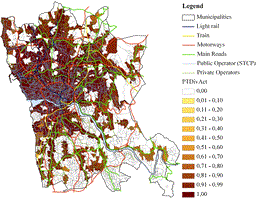1.13 - Urban Mobility Policy: A Framework for the Integration of Land Use and Transport Policies for Sustainable Urban Travel
Project Description
Urban mobility problems, such as traffic congestion, have been threatening quality of life and competitiveness of urban areas as well as their sustainable development. Transport Planning has traditionally been responsible for steering mobility patterns, even though it originally aimed simply at giving answer to travel needs by offering necessary transport infrastructure and services. This "predict and provide" paradigm of traditional transport planning is clearly inadequate for the management of current mobility needs. Within the new "predict and prevent" paradigm, urban mobility management policies are facing new challenges. In this respect, the European Commission has identified the following two main requirements for urban mobility policies: reduction of travel needs and making remaining travel more sustainable. However, these requirements go well beyond the normal scope of transport planning, consequently, the need to integrate land use and transport policies has been widely recognised as a more effective approach.
In spite of the theoretical and empirical evidences of the interaction of land use and transport systems and their combined effect on mobility patterns, and of the broad political and academic recognition for the need to integrate land use and transport policies to foster more sustainable mobility patterns, such integration is seldom put into practice. The lack of design-support tools is pointed out as one of the reasons for the scarce translation of rhetoric and theory of integrated land use and transport policies into practice.
The main aim of my PhD research project is to contribute to the implementation of integrated land use and transport policies for urban mobility management. Given the scarce translation of rhetoric and theory of integrated land use and transport policies into practice, my research centred on the study of the potential of accessibility measures to bridge the gap between rhetoric and practice.
Within this context this research develops an accessibility based design support tool for integrated land use and transport policies for the management of urban mobility. The tool called Structural Accessibility Layer "SAL" maps the conditions given by the urban structure (enclosing land use and transport structure) for the sustainability of potential mobility patterns. The SAL works as a comparative assessment tool of accessibility levels to several activities by transport mode. The usefulness of the SAL as design support tool for integrated land use and transport mobility policies, as well as its practical applicability, are studied based on a case study on the core municipalities of the metropolitan area of Oporto.
Research Team
- Cecília Silva
- Paulo Pinho (Supervisor)
Financial Support
- FCT (SFRH/BD/17502/2004)
Stage of Progress
- Concluded in 2008
